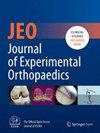The Battleship technique: A reliable method to quantify intraarticular distance maps patterns and correlate hindfoot alignment
Abstract
Purpose
Weight-bearing computed tomography (WBCT) creates colour-coded distance maps (DM) to analyze intraarticular contact areas, offering a detailed assessment of joint surface interactions. However, clinical applications of DM remain underexplored. This study introduces the ‘Battleship technique (BST)’ to evaluate contact area patterns in patients with osteoarthritis (OA) of the talar dome, producing a single point representing the distance map weighted sum (DMWS). The DMWS serves as a potential reference for assessing hindfoot deformities and guiding clinical decisions, including surgical planning and alignment correction. We hypothesize that the BST is reliable for calculating the DMWS and that the DMWS correlates with hindfoot alignment, providing a novel tool to improve the evaluation of complex deformities. The primary aim was to evaluate the reliability of the BST, and the secondary aim was to determine whether the DMWS is influenced by hindfoot alignment.
Methods
Two raters independently calculated DMWS using BST for forty ankle OA patients. Based on DMWS location relative to the joint centre, patients were categorized into coronal (varus/valgus) and sagittal (anterior/posterior) groups. Hindfoot alignment was statistically compared between groups.
Results
Excellent interobserver and intraobserver agreement was observed. Significant differences were found in α angle, tibiotalar surface angle (TSA), hindfoot alignment angle (HFA) and talar tilt (TT) (p = 0.047, p < 0.001, p = 0.003 and p = 0.04) between coronal groups, and in β angle and tibiotalar ratio (TTR) (p < 0.001) between sagittal groups. Correlations were identified between DMWS and TSA (r = 0.6, p < 0.001), TT (r = −0.6, p < 0.001), β angle (r = 0.2, p < 0.001) and TTR (r = −0.4, p < 0.001).
Conclusion
The BST reliably calculates the DMWS, correlating with foot and ankle alignment. BST provides a standardized, non-invasive method to evaluate intraarticular contact patterns, offering valuable insights for preoperative planning and post-operative assessment. Its integration into practice may enhance surgical precision in complex realignment procedures.
Level of Evidence
Level IV.

 求助内容:
求助内容: 应助结果提醒方式:
应助结果提醒方式:


